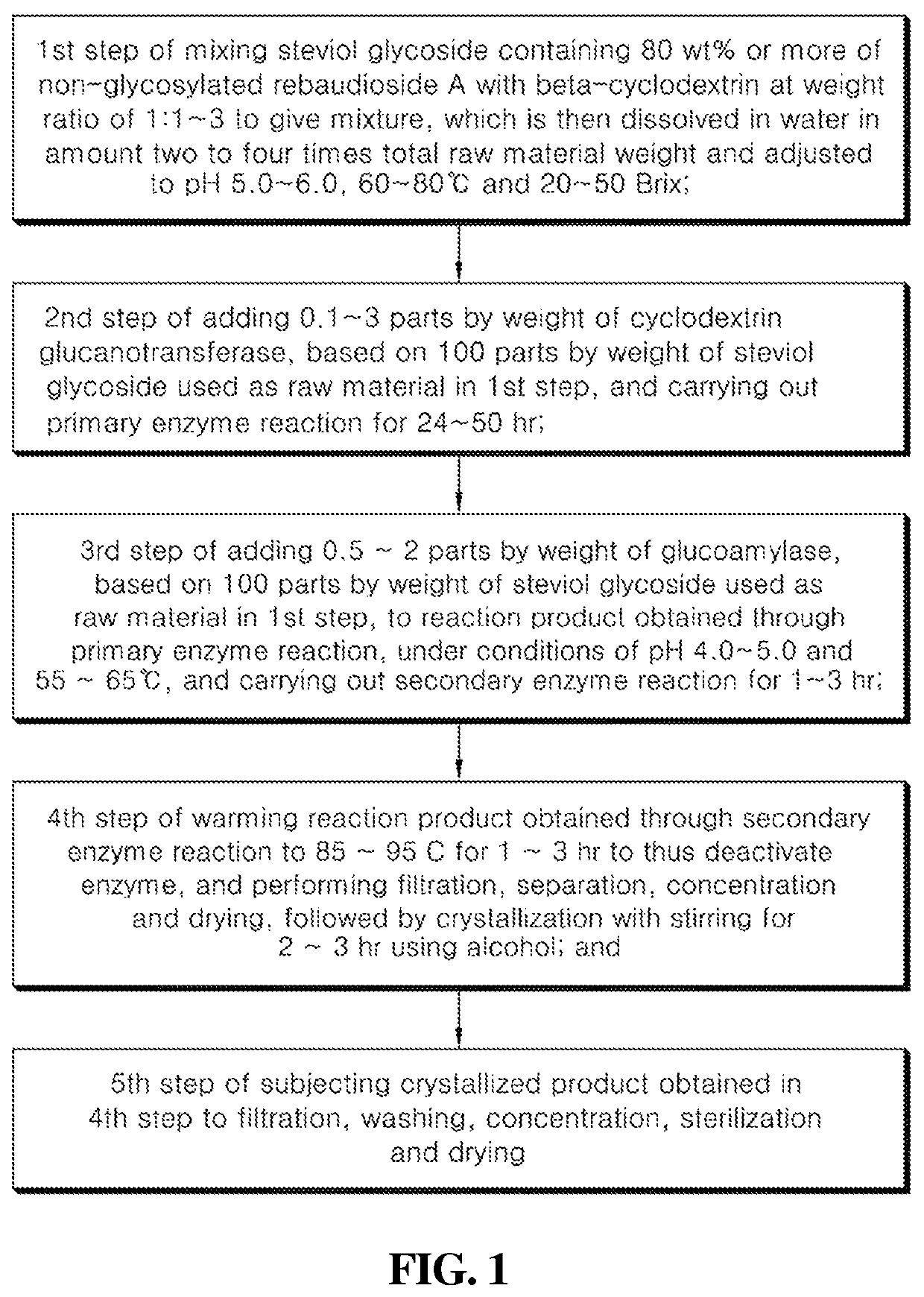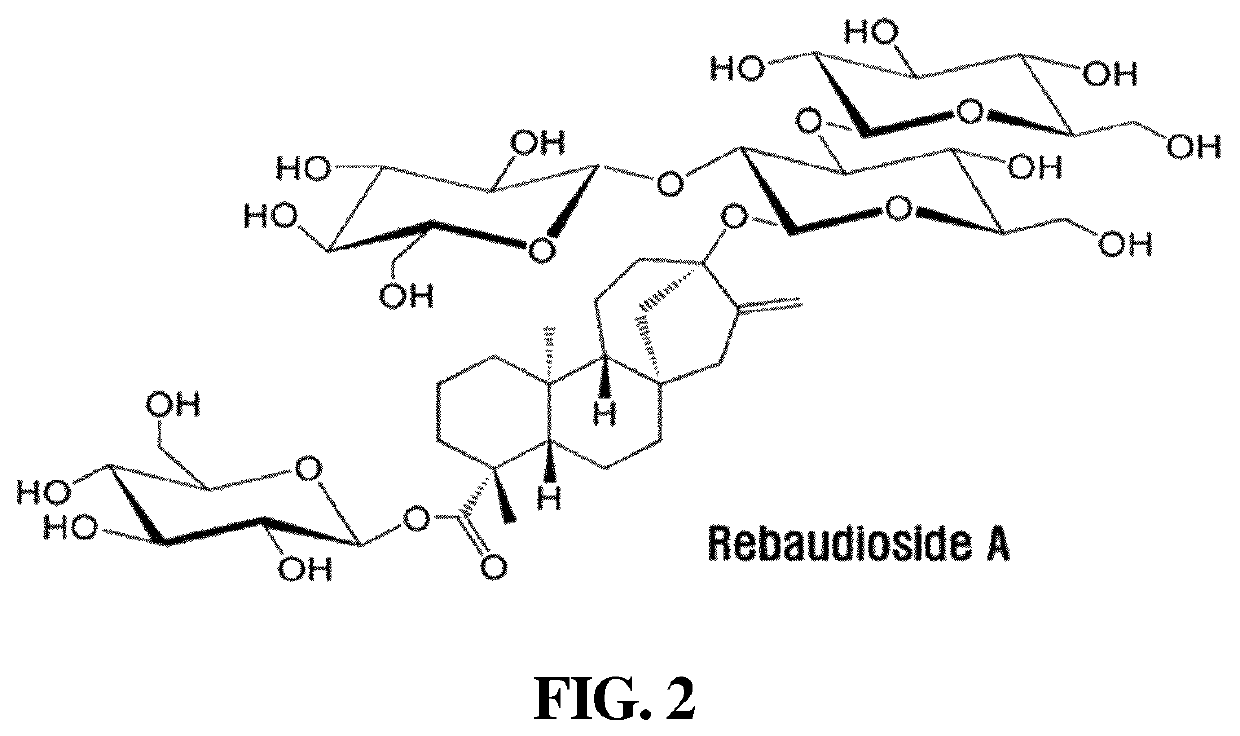Sweetener containing enzymatically modified stevia composition having improved sweetness quality
a technology of enzymatically modified stevia and composition, which is applied in the field of sweetener containing an enzymatically modified stevia composition having improved sweetness quality, to achieve the effects of improving sweetness quality, high total steviol glycoside content, and improving sweetness quality
- Summary
- Abstract
- Description
- Claims
- Application Information
AI Technical Summary
Benefits of technology
Problems solved by technology
Method used
Image
Examples
example 2
Preparation of Enzymatically Modified Stevia Composition ii
[0055]An enzymatically modified stevia composition was prepared in the same manner as in Example 1, with the exception that ethanol crystallization was performed (at 25° C., without warming) using a 90% (v / v) methanol aqueous solution at room temperature, and washing with a 90% (v / v) methanol aqueous solution was performed after centrifugal filtration. Here, in the same steps as in Example 1, RA glycosylation rate, total rebaudioside A proportion in total steviol glycoside, and the proportion of each RA ingredient in the total rebaudioside A were measured. The results are shown in Table 5 below.
[0056]
TABLE 5TotalsteviolTotal RAglycosideproportioncontentRAin reactionEach RA proportion in reaction product(%) inGlycosylationproductRARAG1RAG2RAG3RAG4RAG5RAG6YieldreactionProcessrate (%)(%)(%)(%)(%)(%)(%)(%)(%)(%)product1)90.479.979.615.516.616.115.914.411.9——2)73.779.1826.366.96.8—————3)73.980.1426.164.68.80.5———117.5—4)74.279.79...
example 3
Preparation of Enzymatically Modified Stevia Composition iii
[0057]The primary enzyme reaction1), secondary enzyme reaction2), diatomite filtration, membrane separation, concentration and spray drying3) of the stevia extract were performed in the same manner as in Example 1, after which the powder obtained through spray drying was treated with a 85% (v / v) methanol aqueous solution, a 90% (v / v) methanol aqueous solution or a 95% (v / v) methanol aqueous solution in a volume three times the weight thereof, and crystallized with stirring for 2˜3 hr. Thereafter, centrifugal filtration, washing5) with the same alcohol as in the crystallization, concentration, UHT sterilization (ultrahigh-temperature sterilization) and then spray drying6) were performed. In such processes, RA glycosylation rate, total rebaudioside A proportion in total steviol glycoside, and the proportion of each RA ingredient in the total rebaudioside A were measured. The results are shown in Table 6 below.
[0058]
TABLE 6Tot...
example 4
Preparation of Enzymatically Modified Stevia Composition iv
[0059]An enzymatically modified stevia composition was prepared in the same manner as in Example 1, with the exception that ethanol crystallization was performed using a 90% (v / v) ethanol aqueous solution or a 95% (v / v) ethanol aqueous solution, and washing after centrifugal filtration was performed using the same ethanol aqueous solution as in the crystallization. In such processes, RA glycosylation rate, total rebaudioside A proportion in total steviol glycoside, and the proportion of each RA ingredient in the total rebaudioside A were measured. The results are shown in Table 7 below.
[0060]
TABLE 7TotalTotalsteviolRAglycosideproportioncontentRAin reactionEach RA proportion in reaction product(%) inGlycosylationproductRARAG1RAG2RAG3RAG4RAG5RAG6YieldreactionProcessrate (%)(%)(%)(%)(%)(%)(%)(%)(%)(%)product1)90.589.229.514.917.116.616.014.211.7——2)73.786.8626.365.87.9——————3)70.789.5629.365.25.5——————6)90% (v / v)79.586.2420.576...
PUM
 Login to View More
Login to View More Abstract
Description
Claims
Application Information
 Login to View More
Login to View More - R&D
- Intellectual Property
- Life Sciences
- Materials
- Tech Scout
- Unparalleled Data Quality
- Higher Quality Content
- 60% Fewer Hallucinations
Browse by: Latest US Patents, China's latest patents, Technical Efficacy Thesaurus, Application Domain, Technology Topic, Popular Technical Reports.
© 2025 PatSnap. All rights reserved.Legal|Privacy policy|Modern Slavery Act Transparency Statement|Sitemap|About US| Contact US: help@patsnap.com



